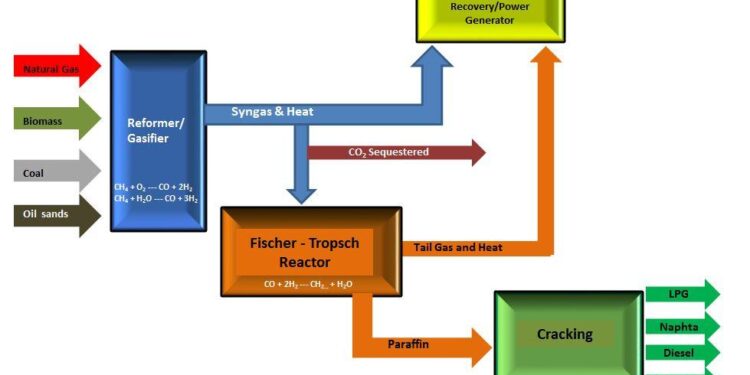In an era marked by shifting geopolitics and growing energy uncertainties, nations worldwide are seeking innovative solutions to bolster their energy security and economic stability. Gas-to-liquids (GTL) technology, often overshadowed by more conventional energy discussions, offers a compelling avenue to transform abundant natural gas resources into versatile liquid fuels. This transformation not only diversifies energy portfolios but also enhances national resilience by reducing dependence on imported oil and mitigating supply disruptions. As The Strategist explores, the adoption of GTL technology stands at the intersection of energy innovation and strategic foresight-promising a pathway toward a more self-reliant and adaptable energy future.
Gas to Liquids Technology as a Catalyst for Energy Security
As global energy demands evolve, the ability to convert abundant natural gas into high-quality liquid fuels presents a strategic advantage. This innovative process not only diversifies the energy supply but also enhances national self-reliance by reducing dependence on volatile oil imports. By leveraging existing gas reserves, countries can produce cleaner, more stable fuels that integrate seamlessly with current infrastructure. Moreover, the adaptability of gas-to-liquids technology offers a flexible response to market fluctuations, ensuring consistent fuel availability in times of geopolitical tension or supply disruptions.
The multifaceted benefits extend beyond energy security into economic resilience. Nations embracing this technology can stimulate domestic industries, generate jobs, and foster technological innovation. Key strengths include:
- Lower carbon footprint: Produces cleaner fuels compared to conventional refining.
- Fuel quality: Yields ultra-clean diesel and jet fuels compatible with existing vehicles and aircraft.
- Integration potential: Fits smoothly within established supply chains without need for costly infrastructure changes.
| Benefit | Impact |
|---|---|
| Energy Stability | Reduced import reliance |
| Economic Growth | Job creation and tech advancement |
| Environmental | Cleaner emissions |
Unlocking Economic and Environmental Benefits through GTL Innovation
Gas-to-liquids (GTL) technology stands at the forefront of transforming natural gas-a typically underutilized resource-into high-value liquid fuels and chemicals. This conversion not only provides a cleaner alternative to conventional fossil fuels but also opens avenues for boosting economic growth by creating new supply chains and diversifying energy portfolios. Countries can harness GTL plants to reduce dependence on imported fuels, stabilize local markets, and generate high-skilled jobs across manufacturing, engineering, and environmental sectors.
Beyond the economic uplift, GTL innovation offers notable environmental advantages by producing fuels with:
- Lower sulfur and particulate emissions
- Improved combustion efficiency
- Reduced greenhouse gas footprint compared to traditional petroleum-based fuels
| Benefit | Impact |
|---|---|
| Energy Security | Reduced reliance on volatile global oil markets |
| Environmental Quality | Cleaner air through low-emission fuels |
| Economic Diversification | New industrial and export opportunities |
Strategic Policy Measures to Harness GTL for National Resilience
To fully capitalize on gas-to-liquids (GTL) technology, governments must implement forward-thinking policies that nurture innovation while safeguarding strategic interests. This includes incentivizing R&D investment to improve fuel efficiency and production scalability, alongside establishing stable regulatory frameworks that encourage private sector partnerships. Prioritizing infrastructure upgrades to support GTL facilities and supply chains will ensure seamless integration with existing energy systems, helping to mitigate disruptions during geopolitical or market shocks.
Effective policy frameworks should also emphasize diversification and resilience by:
- Promoting modular GTL plants for rapid deployment in critical regions
- Incorporating GTL fuels into national strategic reserves for emergency readiness
- Facilitating workforce training programs to build a pipeline of specialized expertise
- Encouraging environmental safeguards to align GTL deployment with sustainability goals
| Policy Area | Focus | Expected Impact |
|---|---|---|
| Innovation Grants | Fuel efficiency improvements | Lower production costs, cleaner fuels |
| Regulatory Stability | Long-term investments | Increased private sector confidence |
| Strategic Reserves | Energy security | Buffer against supply shocks |
In Summary
As nations navigate an increasingly complex global energy landscape, gas-to-liquids technology presents a compelling avenue to bolster resilience and secure more stable fuel supplies. By transforming abundant natural gas into versatile liquid fuels, this innovation not only diversifies energy portfolios but also reduces reliance on volatile oil markets. While challenges remain, embracing gas-to-liquids could empower countries to build more adaptable and self-reliant energy systems-an essential step toward safeguarding economic stability and national security in an unpredictable future.































